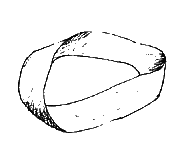
Assignment 15
Task
Sort a list of user-entered grades.
Textbook: 3.1, 4.1 - 4.2
Concepts: creating instances (objects), instance variables.
Steps
Ask the user to enter a series of grades, associating a name (a String) with each grade (a double). When the user is done (indicated by entering nothing for a name), print all the grades they entered in sorted order, starting with the highest grade value.
Internally, your program must store the grades in an ArrayList of Student objects. Use this class definition for Student: Student.java. (You don't need to do anything special to use this class in your program--no importing or pasting required. Just save the file in the same directory as your UsernameA15.java file, and Java will find it.)
Sample Output
This program will sort the grades you enter. Enter a student name (or nothing to stop): Jim T. Enter grade for Jim T.: 9.9 Enter a student name (or nothing to stop): Bobby Enter grade for Bobby: 10 Enter a student name (or nothing to stop): Sally Enter grade for Sally: 5.4 Enter a student name (or nothing to stop): Jenny Enter grade for Jenny: Fred Bad input: please enter a number. Enter grade for Jenny: oops Bad input: please enter a number. Enter grade for Jenny: 9.5 Enter a student name (or nothing to stop): Fred Enter grade for Fred: -1 Enter a student name (or nothing to stop): Jim P. Enter grade for Jim P.: 8.3 Enter a student name (or nothing to stop): You entered: Bobby: 10.0 Jim T.: 9.9 Jenny: 9.5 Jim P.: 8.3 Sally: 5.4 Fred: -1.0
Tips
- Review A14--most of the program logic is the same.
- It would be possible to use only
nextLine()andnextDouble()for this one, and forgoparseDouble. However, if you do, you'll need to remember to clear the input stream of the newline (by callingnextLine()) before reading the next name. [Update: see FAQ below for more.] - Don't forget to create a new Student object for each student you're putting into the ArrayList. (If you forget to do this, every object in the ArrayList will actually be a reference to the same single Student.)
- The tab character ('\t') is handy for formatting columned output.
What to Submit
Upload your UsernameA15.java file to Tamarin. (You do not need to include Student.java at all; Tamarin already has a copy of it.)
Grading [5 points]
- 1 - Compiles + Coding Standards
- Your program compiles successfully (no errors). Your code follows Java coding standards.
- 1 - Input
- Your program repeatedly prompts the user to enter a student grade (a name followed by a
doublegrade). The program stops if the user enters nothing for the name (empty string); does not stop on bad numerical input. - 1 - ArrayList<Student>
- Your program uses an ArrayList of Student objects to store the grades read in from the user
- 1.5 - Output
- Your program then prints out a list of all the grades the user entered, displaying both the name and the grade for each .
- 0.5 - Correctly sorted.
- When the program prints out the entered grades, they are in sorted order, from highest to lowest grade value.
FAQs
- I'm using
nextDouble()to read in the number, but my program is acting weird, such as ending after it reads in the number or infinitely looping if the user doesn't enter a number! - I didn't get to talk about clearing the input stream as much as I would have liked in lab this week. (Not at all in Robertson's section!) But have a look at the comments in this sample code (and try what they suggest) and hopefully this behavior will make sense: InputTrouble.java
- How do I access the instance variables within an object in the list?
- The point of this assignment is to show that an object (without methods) is just a bundle of variables. Specifically, every
Studentobject is just anameand agrade. This means we can pass around or sort whole Student objects, and all their internal fields are passed around and sorted along with the object.So, this means that when you get an object out of the list, you get a
Studentobject. So you may want to do something like this:Student fromList = list.get(i);
Now, if you just try to print this whole object, Java is only going to display the class name and address of this object, giving you something like this:
Student@1a748cb. (It does this because you haven't defined how Java should print out a Student object; we'll learn how to do this soon.) Instead, you need to access and print each of its fields separately:System.out.println("Name: " + fromList.name); System.out.println("Grade: " + fromList.grade);If you only need access to a single field (such as when sorting), you could combine these next two lines:
Student s = list.get(i); if (s.grade ...
as follows:if (list.get(i).grade ...
The lesson here is: first, get the whole Student object out of the list, and then access the particular field/instance variable that you want within that particular object.
- How do I load the list with
Students in the first place? - Assuming you have an
ArrayList<Student>namedlist, you would need to do something like this:while (/*user still wants to enter things*/) { Student nextStudent = new Student(); //get name and grade details from user and then load Student object nextStudent.name = ... nextStudent.grade = ... list.add(nextStudent); }Of course, this adds the next item to the end of the list, so now you'd have to sort the list after the user is done entering data. The alternative is to add each
nextStudentinto the list in sorted order. Any sorting is now based on thegradefield of each student in the list, but otherwise the sorting process is exactly the same as for A14.